The Oriental Shorthair
and the Bengal are used to create the
Serengeti Cat
Breeders of Serengeti cats have the unique challenge and pleasure of developing a new breed from the genetic material available in select Oriental Shorthairs and Bengals. In each succeeding generation we should strive to move closer to the ideal Serengeti by selecting only the best Serengetis to breed on from and from carefully choosing Orientals, Bengals or other Serengetis that complement them.
Selecting Oriental breeding stock to create Serengetis
Oriental Shorthairs to be used for foundation stock for Serengeti Cats should have ear placement towards the top of their heads as well as extremely large ears. Orientals that are more heavy bodied should also be used. It also would be an advantage to use cats with a rounder eye. Finally, individuals should be selected from lines that are predominantly from non-dilute, spotted tabby lines when possible.
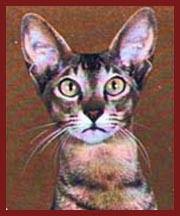
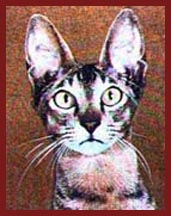
These two photographs are of the same oriental shorthair, one natural and one in which the ears have simply been moved to the top of the cat's head. Even without enlarging the ears or changing the shape it is obvious that the head looks quite different just by simply moving the ears.
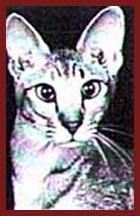
This is a photograph of an Oriental Shorthair that has the beginnings of the correct size and shape ears and whisker pads for the Serengeti Cat. This cat would be a good choice for a breeding program for Serengeti cats.
Selecting Bengal Foundation Stock
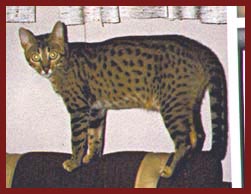
This Bengal has many useful traits for a Serengeti breeding program.
Bengals of good size and substance with a more upright stance than is wanted in the Bengal standard should be used.
Also, Bengals with larger than ideal ears placed high the head are very useful since breeding back to Bengals seems to bring ears size down quickly.
Cats with large round eyes are also important.
Cats with a distinct spotted pattern should be used rather than those that show any sign of bars. Spotted legs and hips are very useful. Rosetted or marble bengals are not as useful, as the serengeti is a spotted cat, not a rosetted cat.
Cats with a very clear beige to gold coat with black markings are useful to counteract the ticking that comes from the Oriental heritage.
And finally, individuals should be selected from lines that do not carry the marble pattern (classic tabby) or the "snow" color (Siamese or Burmese), if possible.
First generation Serengeti Cat
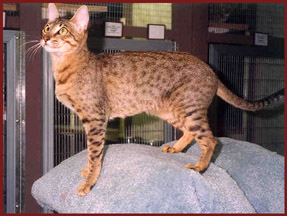
This female is the product of breeding an oriental shorthair male with a female small spotted bengal. While she certainly does not look like a serval, she has started the process of creating the "look". She has very upright ears and round eyes. Her neck is long and she stands quite erect. While she has small spots, she is, unfortunately, heavily ticked. She is about 10 pounds. Not a big cat, but not bad for a female.

Kingsmark Bengal and Serengeti Cats
Marana, AZ
E-mail: KSerengeti@aol.com
| All About Serengeti Cats |
My Serengeti Photo Gallery |
|---|---|
| Serengeti Show Standard |
Serengeti Illustrated Standard |